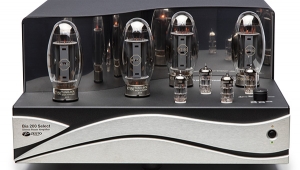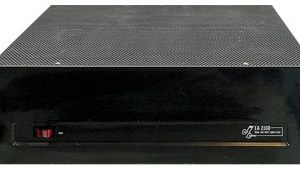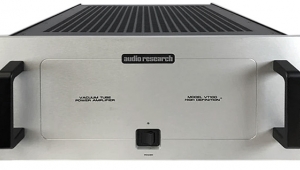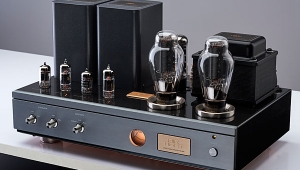| Columns Retired Columns & Blogs |
Audiopax Model Eighty Eight monoblock power amplifier
Ah, Brazil...land of coffee, the samba, Pelé, Rio-by-the-sea-o, and tube amplifiers. All right, so perhaps the amplifier connection isn't quite as well-established. But one Brazilian amplifier designer, Eduardo de Lima, has published articles in Glass Audio magazine that are viewed by many as groundbreaking, and his evolving products have been seen at various specialist tube equipment shows. De Lima—president, founder, product designer, and principal owner of Audiopax Sistemas Eletroacusticos—is an electrical engineer who started out designing equipment for a telecommunications company, but since 1995 he's devoted his talents to designing a wide range of audio products, including speakers as well as preamps and power amps.
 The Audiopax Model Eighty Eight represents the latest refinement of de Lima's thinking about power amplifiers, and was developed for the North American market in consultation with Avantgarde-USA, which distributes the amps. As Avantgarde-USA's Jim Smith tells the story in his inimitable personal style on the company's website, he was urged independently by several audiophiles to listen to a new amplifier from Brazil for which they were making claims of "best I ever heard." He decided to follow up on this by asking de Lima to send him a pair of amplifiers to evaluate. The rest, as they say, is history. As the owner of a pair of Avantgarde Unos myself (see review in Vol.23 No.8, and the Follow-Up on the series 3.0 in Vol.25 No.8), I just had to check out the Audiopax Model Eighty Eight to see what all the fuss was about.
The Audiopax Model Eighty Eight represents the latest refinement of de Lima's thinking about power amplifiers, and was developed for the North American market in consultation with Avantgarde-USA, which distributes the amps. As Avantgarde-USA's Jim Smith tells the story in his inimitable personal style on the company's website, he was urged independently by several audiophiles to listen to a new amplifier from Brazil for which they were making claims of "best I ever heard." He decided to follow up on this by asking de Lima to send him a pair of amplifiers to evaluate. The rest, as they say, is history. As the owner of a pair of Avantgarde Unos myself (see review in Vol.23 No.8, and the Follow-Up on the series 3.0 in Vol.25 No.8), I just had to check out the Audiopax Model Eighty Eight to see what all the fuss was about.
Design and Description
The theory behind the Audiopax Model Eighty Eight is described in a set of papers available at the Avantgarde website. They make fascinating reading for those with a technical bent, and provide a great deal more information than I can here. Much of the thinking is highly original, and some of it flies in the face of accepted wisdom. The Eighty Eight uses single-ended rather than push-pull topology, but, unlike the darlings of the single-ended amplifier world, it's not triode but pentode. Oh, no!
But wait—although the Eighty Eight is pentode, it has Perfect Triode Simulation (PTS), which uses a variety of techniques to produce sound that's said to combine the best qualities of expensive 300B, 2A3, and 45 tubes, but using two ordinary KT88s per channel rather than a single tube, and with much higher output capability: 30W rather than 2-7W. Then, contrary to the view that the fewer the amplifier stages, the better, each Eighty Eight monoblock consists of two amplifiers in one chassis, connected in a series configuration. At least there's no global feedback. (Whew!)
The two component amplifiers have slightly different characteristics, the output transformers having asymmetries "to achieve the intended result." Again in contrast to usual high-end design practice, the transformers (designed in-house and built under de Lima's direct supervision) are quite small for the output power. According to de Lima, the transformers are small not to save money, but to produce the desired sound quality and frequency range (14Hz-90kHz, -3dB, 0.0dB down at 20kHz). De Lima feels that the common practice of using as beefy a power supply as possible may impress people, but it's often not optimal for a given circuit. He favors what he calls a Matched Power Supply (MPS), which, as its name suggests, matches the power supply to the particular signal circuit.
In considering the issue of the sonic effects of passive components, de Lima agrees that these can be very important, but different in kind from the effects of circuit design. The analogy he uses is of a piece of glass: circuit design is a tool to make the glass surface better, whereas the components determine the transparency of the glass itself.
The Eighty Eight's most novel aspect is something called Timbre Lock, which promises to optimize the amplifier-speaker interface in a given system. Timbre Lock consists of a pair of knobs, each controlling a potentiometer that sets the bias for one of the KT88 output tubes. A set of LEDs can be switched on to provide an indication of the bias. When the LED in the middle of the range is lit up, the bias is approximately 60mA. Each of the 10 LEDs indicates a change in bias of about 2.5mA, so that the adjustment range is ±12.5mA. According to de Lima, the maximum 72.5mA is well within the KT88's rating, so there's no chance of the tube being overdriven.
- Log in or register to post comments



































